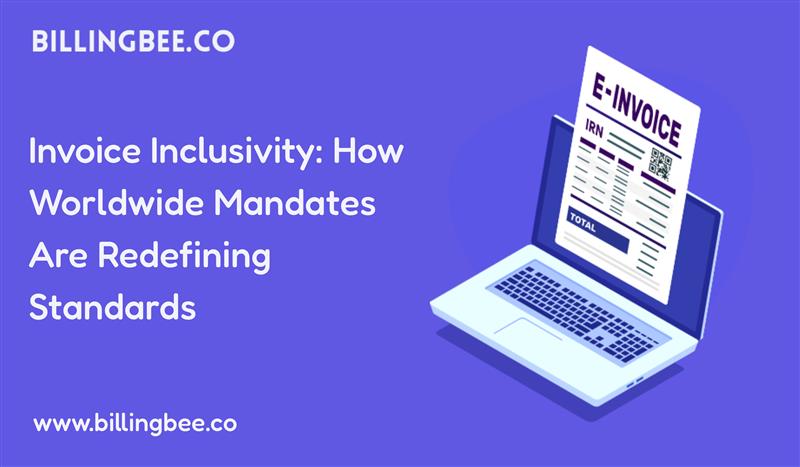Invoice Inclusivity: How Worldwide Mandates Are Redefining Standards




Invoicing is no longer just a backend function buried in a company’s operations. It’s becoming a frontline issue in global commerce—one that touches on accessibility, equity, and localization. As governments across continents update regulations, a powerful shift is unfolding: invoices are expected to be inclusive, both in language and format.
Countries like Brazil, Nigeria, Mexico, and parts of the EU are rewriting the rulebook. The world is no longer satisfied with English-only PDFs and complex financial jargon. Inclusivity—once a soft goal—is becoming a legal standard.
So what does this mean for businesses, freelancers, and digital platforms? Let’s dive deep.
From Compliance to Compassion: Why Invoice Inclusivity Matters
Traditionally, invoices have been designed for accountants, not for the people who actually pay or get paid. But that’s changing.
New global mandates are driven by a simple idea: every person, regardless of language, disability, or digital literacy, should be able to understand their invoice.
This goes beyond nice-to-have formatting. It touches on human dignity, financial clarity, and the right to participate fully in an economy.
Spotlight: Countries Leading the Inclusivity Wave
Brazil: Language + Layout Mandates
Brazil’s government requires e-invoices (Nota Fiscal Eletrônica) to include fields in Portuguese, with emphasis on structured XML formatting and integration with national systems. The aim? Clearer communication, better tax tracking, and broader accessibility for local businesses and customers.
Nigeria: Localization as Empowerment
Nigeria’s e-invoicing mandates emphasize data clarity and local currency accuracy, along with readability for local SMEs. Many regional businesses now issue invoices in Hausa, Yoruba, and Igbo, depending on the clientele, making the invoice a tool of empowerment rather than confusion.
Europe: Accessibility Directives
In the EU, especially countries like Germany and the Netherlands, Web Content Accessibility Guidelines (WCAG) are being applied to invoices sent digitally—making it easier for individuals with visual impairments to access them via screen readers or Braille readers.
India and Southeast Asia: Multilingual Evolution
In regions like Tamil Nadu, Gujarat, or Indonesia, there's a growing push for invoicing in regional scripts—not just translations, but fully localized templates. Some states in India have already mandated certain government receipts be available in native languages alongside English.
What Does an Inclusive Invoice Look Like?
An inclusive invoice isn't just a document. It’s a bridge between businesses and people—regardless of ability, language, or background.
Here's what modern mandates demand:
- Multilingual Support: The ability to generate invoices in both international and native languages.
- Accessible Design: Compatibility with screen readers, clear typography, logical hierarchy of information.
- Mobile Optimization: Many customers in developing economies only access invoices through smartphones. Responsiveness is key.
- Currency Localization: Displaying amounts in local currencies with tax and fee breakdowns clearly explained.
- Minimal Jargon: Simpler, more transparent language, especially for non-corporate clients or microbusinesses.
Why This Shift Matters to Everyone
Even if you're not operating in Brazil or Nigeria today, the writing is on the wall. These changes aren’t isolated—they’re prototypes for what's coming globally.
- Freelancers working with international clients will soon need to adapt their invoices for different languages or standards.
- Startups and SaaS platforms need to consider compliance across markets, or risk alienating customers—or worse, facing fines.
- Small businesses must begin to think about invoice readability not just as good practice but as customer service.
Inclusivity = Opportunity
There’s a powerful upside to all this.
By making your invoicing more inclusive, you’re not just complying—you’re expanding your reach. You’re building trust with customers who feel seen and understood. And you're future-proofing your business in a world that’s increasingly multilingual, digital-first, and accessibility-conscious.
Inclusivity isn’t just about avoiding penalties. It’s about building relationships across borders, languages, and life experiences.
Final Thought: The Future Is Human
Global commerce has always been about connection. Now, invoicing is catching up.
The quiet revolution in how we bill each other is driven by a simple but profound idea: everyone deserves to understand how they’re getting paid—or paying. No fine print. No foreign language roadblocks. No digital walls.
Invoice inclusivity is no longer optional. It’s inevitable.
And it’s about time.